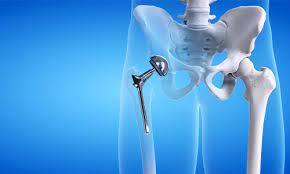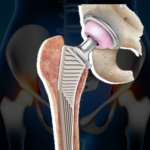
Hip replacement surgery, also known as hip arthroplasty, is a common surgical procedure performed to alleviate pain and improve mobility in individuals suffering from hip joint damage or degenerative conditions such as arthritis. In this blog, we will explore how hip replacement surgery works, the different types of procedures, and the recovery time associated with this transformative surgery.
Understanding Hip Replacement Surgery:
The hip joint is one of the largest weight-bearing joints in the body. It consists of the femur (thigh bone) and the acetabulum (socket) in the pelvis. During hip replacement surgery, the damaged or diseased parts of the hip joint are removed and replaced with artificial components made of metal, ceramic, or plastic.
Procedure:
- Preoperative Evaluation: Before the surgery, the patient undergoes a comprehensive evaluation, including medical history review, physical examination, and diagnostic tests such as X-rays or MRI scans. This helps the medical team plan the most appropriate surgical approach.
- Anesthesia: Hip replacement surgery is performed under general anesthesia, which means the patient is unconscious and feels no pain during the procedure. In some cases, regional anesthesia (spinal or epidural) may be used.
- Incision: The surgeon makes an incision on the side or back of the hip, exposing the joint.
- Removing Damaged Tissues: The damaged cartilage and bone at the hip joint are carefully removed.
- Implant Placement: The artificial components are meticulously placed in the hip joint. The femoral component is inserted into the hollow center of the femur, and the acetabular component is fixed into the socket.
- Closure: The incision is closed using sutures or staples, and a sterile dressing is applied.
Types of Hip Replacement Surgery:
- Total Hip Replacement: This is the most common type of hip replacement surgery. It involves replacing the entire hip joint with artificial components.
- Partial Hip Replacement: In certain cases, only the femoral head is replaced, leaving the acetabulum intact. This procedure is performed when the damage is limited to the femoral head.
- Minimally Invasive Hip Replacement: This technique uses smaller incisions and specialized surgical instruments, resulting in potentially faster recovery and reduced scarring.
Recovery Time:
The recovery time after hip replacement surgery varies from person to person, but generally, it involves the following phases:
- Hospital Stay: Most patients remain in the hospital for a few days after surgery. During this time, pain management, physical therapy, and monitoring of the incision site are crucial.
- Rehabilitation and Physical Therapy: After discharge, a rehabilitation program is initiated to help restore strength, flexibility, and mobility. Physical therapy exercises are designed to improve walking, balance, and joint function.
- Home Recovery: Patients are typically able to return home within a week or two after surgery. It is important to follow the prescribed medication regimen, exercise regularly, and avoid activities that could stress the new hip joint.
- Full Recovery: While individual recovery times may vary, it typically takes several weeks to a few months to regain normal mobility and function. However, it may take up to a year to fully recover and experience the maximum benefits of the surgery.
Conclusion:
Hip replacement surgery is a highly effective procedure for relieving hip pain and improving quality of life. By replacing damaged joint components with artificial ones, patients can regain mobility and return to an active lifestyle. Although recovery time varies, proper postoperative care, adherence to physical therapy, and patience are essential for a successful and complete recovery. If you are considering hip replacement surgery, consult with an experienced orthopedic surgeon to determine the best treatment plan for your specific condition.




